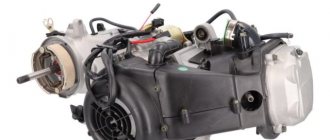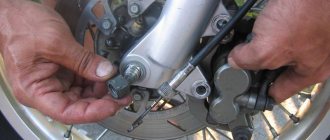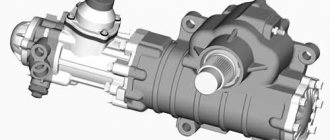Any vehicle needs periodic maintenance. A scooter is not as complex a piece of equipment as a car, but it also requires constant care. One of the operations on which reliable movement depends is changing the oil in the T4 scooter gearbox.
The list of main components of a scooter includes a gearbox. During movement, the unit is subject to heavy loads. If you do not change the transmission oil in a timely manner, premature wear of parts may result in further failure.
A scooter's gearbox consists of rubbing gears and bearings that constantly receive enormous load. To avoid their rapid wear, you should monitor the presence of lubricating fluid in the unit. Thanks to the high-quality liquid, which contains various functional additives, all parts of the element will be protected from rapid wear, jamming and corrosion.
To change the oil in a scooter gearbox, you will need the following tools:
a container into which you can drain used oil with a key for 10 syringes or, but you can get by with a funnel, transmission oil
So what should the gearbox be filled with?
There are three options for refilling it. There is a special Motul Scooter Gear transmission oil on sale. The disadvantages of this oil are the following: the tube holds only 150 ml, in many scooters the gearbox holds 90 ml, which means there will be one and a half refills in one tube, neither here nor there. And the price for it is quite significant at around 250 rubles. One of the advantages is the very convenient spout in the tube.
But you can use other automotive gear oils with a viscosity of 80W-90 or 75W-90. For the same amount you can buy a whole liter of non-scooter oil, which will work just as well. 2
Taking into account the fact that the scooter gearbox does not contain hypoid gears, motor oil with a viscosity of 10W-30 can be used as gear oil. And if the scooter is used in cold conditions at temperatures below +5 ° C, engine oil will be more suitable, since it is thinner
In our opinion, the best option is the oil used in automatic transmissions (automatic transmissions), it is called ATF transmission fluid
This oil has the best fluidity, which makes it simply irreplaceable at low temperatures, although this is not so important for scooters. Having excellent protective action of gears, it foams minimally
The price of such ATF oil ranges from 170 rubles per liter. For scooters, the cheapest one will do.
How to properly drain old oil
It is very important that the oil change is carried out immediately after the trip, then all the sediment will rise from the bottom of the gearbox. You can also start the engine and let it run until it warms up.
It's much easier if you have a drain bolt. We place the prepared container under it, unscrew the bolt and drain the oil completely, then screw it back.
If there is no drain bolt, oil is filled and drained through the same bolt. In this case, when draining the oil, the scooter must be tilted on its side.
If you haven’t changed the oil for a long time, it will look like this:
Color of used oil (working off)
The metallic color of the oil (waste oil) indicates abrasion of the working surfaces of the gears. So don't be alarmed, this is a normal process when grinding in parts.
How to fill new oil correctly
An indication of the oil volume must be stamped on the gearbox housing. It is more convenient to pour in already measured oil using a medical syringe. But if this is not at hand, you can fill the oil to the bottom of the thread of the filler bolt. This will be the correct volume, given that the scooter should be in an upright position.
Gearbox
When tightening the bolt, you should not use force, since the engine body is made of silumin and you can easily lose the thread if you overdo it.
Types of oils by basics
Mineral
Mineral motor oils for small-capacity motorcycles are ineffective due to increased carbon formation and rapid aging. Since the volume of product poured into scooter engines is small, it will have to be replaced frequently. To ensure sufficient protective properties, an increased volume of additives must be introduced into the composition of mineral oil.
For two-stroke engines, mineral oils are the least applicable, as they burn with high smoke and abundant soot formation. Because of this, the engine and exhaust system have to be cleaned regularly, and savings on oil are offset by the complexity of maintenance.
Semi-synthetic
Oils that compromise in terms of price-quality ratio combine a mineral base with the addition of synthetic components. They can be used in most scooter engines, with the exception of the most forced ones.
In four-stroke engines, such oils provide high-quality splash lubrication and well protect loaded friction pairs. In two-stroke engines, switching from mineral to semi-synthetic oil not only increases the service life, but also makes it much less likely to disassemble the engine to remove carbon deposits.
Synthetic
The highest quality oils suitable for use in the most complex and powerful scooter engines. Due to their high thermal stability, they work well in air-cooled motors. The ability to control the composition and properties of the synthetic base directly at the stage of its production makes it possible to create low-smoke two-stroke oils that form a minimum of soot.
Gearbox design in the T4 scooter
What kind of oil to pour into the gearbox of a walk-behind tractor
? The gearbox consists of a set of gears, which are located in a common housing - in the crankcase. Thanks to the presence of the crankcase, all parts are located compactly. The crankcase protects all elements from mechanical damage and contamination, providing good lubrication of gearbox parts.
A gearbox is necessary to adjust the speed of rotation of the shafts down or up. On a scooter, this element is located between the secondary clutch shaft and the wheel.
The gearbox is divided into primary and secondary gears:
- The primary gear is the first and second gears.
- The secondary gear includes the third and fourth gears.
Both gears always consist of two gears - one large and the other small.
There is a hole in the gearbox housing for draining and filling fluid. The filler plug is just a regular bolt and washer. Transmission oil is poured into the scooter. It is advisable to check the fluid level in the crankcase once a month.
If the oil level has dropped or is completely absent, the gearbox begins to make an extraneous noise. Extraneous noise is produced by worn gears with a small amount of lubricant. And this will lead to wear of gears, bearings and bushings.
Draining the oil and flushing the gearbox
So, having selected the right lubricant for the regulator, you can begin to drain the old oil. Changing the scooter oil in the gearbox is carried out when the scooter is warmed up. To do this, it is enough to ride a scooter for 20 minutes before the change process. The heated liquid becomes more liquid, and this will help quickly drain the waste along with dirt or metal debris.
Draining the oil and flushing the gearbox:
- Wipe the drain and filler (bolt) holes with a clean rag.
- The filler hole is located at the rear of the power unit.
- Unscrew the nuts from the filler bolt, and then from the drain hole.
- Substituting an empty container, drain the old liquid.
- While the old oil is draining, wash the removed nuts and bolts in gasoline.
If metal particles are found when draining the old oil, the regulator housing should be flushed. To do this, remove any remaining lubricant from the crankcase and fill in transmission oil to flush it. The viscosity of the flushing fluid should be higher.
To flush the gearbox housing, you must:
- Tighten the drain bolt and then the filler hole.
- Start the power unit and rev it up a little.
- Drain the washing mixture.
- Tighten the drain hole.
This completes the process of draining the old fluid from the scooter gearbox. Changing the oil in the gearbox of a 4t 50q scooter is completed by filling in new fluid.
Filling with new oil
After draining the old lubricant and flushing the gearbox system, all that remains is to fill the transmission oil. Moped manufacturers recommend using the following modifications 75W90, SAE 80W90, 85W90 with API quality class: GL-4; GL-5.
The required volume of lubricant is always indicated on the gearbox. Use a large syringe to take the required amount of oil and pour it into the filler hole.
If you don’t have a syringe, you can simply fill the liquid to the lower level of the filler hole. The vehicle must be in an upright position when filling the oil. After pouring oil into the T4 scooter gearbox, wipe the filler bolt and plug dry. Carefully tighten the filler bolt and check the tightness of the connections.
In conclusion, I would like to note that the long-term performance of the scooter gearbox depends on regular maintenance such as timely replacement of transmission fluid.
The condition of the air filter is very important for a scooter.
The air filter is an important element in the scooter's power system. The filter must always be clean, not have even a little dirt, especially not be clogged with dirt, dust, poplar fluff and other evil spirits. Otherwise, this dirt will prevent the free flow of fresh air into the carburetor, which will change the air/gasoline ratio in the combustible mixture (making it richer); also, this dirt will certainly penetrate into the carburetor, clog the jets, tubes, etc., which in turn will also change the air/gasoline ratio in the combustible mixture (make it lean); and finally, in the worst case scenario, foreign small particles will penetrate into the combustion chamber, which can damage the cylinder walls and reduce compression; in other words, the engine will grunt. So, clean your air filter more often.
Scooters often use “zero” resistance filters made of special foam rubber. Such a filter requires very regular maintenance: washing and impregnation of the foam rubber with a special oil that can gel.
Oil for impregnating filters is produced according to a special recipe, although it is quite normal to use regular engine or transmission oil. Oil prevents water, dust and dirt from entering the engine. The due date for the next scooter filter service can be determined by the “fading” of the filter color. Learn more about cleaning your scooter's air filter.
Gearbox oil change timing
What kind of oil should be poured into the engine
That is why, for reliable operation of the scooter as a whole, it is necessary to observe the timing of fluid replacement. In most cases, the frequency of oil changes and the recommended lubricant class are indicated in the manufacturer's instructions. If there is no information about the timing of the change, the oil in the scooter gearbox is changed every three to five thousand kilometers or once a year.
A sufficient oil level in the gearbox reduces shock loads, vibrations and extraneous noise. Due to the enormous loads on a Chinese scooter, constant care of the vehicle is required. After a certain time or mileage, the oil loses its quality, becoming saturated with metal elements and forming sediment. And this will lead to a deterioration in the lubricating properties of the fluid, without providing reliable protection. Without sufficient fluid in the gearbox, this part may quickly break down.
When purchasing a new vehicle, changing the oil in the gearbox on a scooter is done more often. The first fluid change on a new scooter is carried out after 300 km, and the second time after 1000 km. But the quality and reliability of driving a moped also depends on the required oil level in the gearbox. In order for the level to comply with the standards, it is necessary to check it every 2.5 thousand kilometers and, if necessary, top up the fluid.
Considering the timing of fluid changes, we must not forget about the correct choice of oil. When purchasing lubricant, you should always take into account the recommendations of the scooter manufacturer. The gearbox can be filled with Motul Scooter Gear transmission oil, although its volume is only 150 ml; liquid with viscosity 80W-90 or 75W-90. It is allowed to fill the gearbox with motor oil with a viscosity of 10W-30. The most acceptable fluid option for a scooter is ATF gear oil, which has good fluidity and excellent protection properties.
What to fill the gearbox with?
When you choose oil for a scooter gearbox, the question often arises, which is better in terms of base quality, composition and price.
All oils are divided into three types based on their base:
- synthetic;
- semi-synthetic;
- mineral.
The choice of oil depends on the season.
The synthetic type includes those whose packaging bears the designation Fully Synthetic. Such components retain their original properties more than others and are resistant to overheating and low temperatures.
Semi-synthetic is most suitable for engines with considerable mileage. Semi-Synthetic - this is how semi-synthetic fluid is usually designated. There are impurities, which makes the cost of products lower and the quality worse (when compared with synthetic ones).
Mineral is designated Mineral. The cheapest, as it is a product of oil waste. These components tend to thicken quickly and, when boiling, leave deposits on the engine.
Mixing different based components is not allowed.
Replacement algorithm
What kind of oil to pour into the Lada Vesta engine
Motor oils come in mineral, synthetic and semi-synthetic bases.
There is no need to skimp on lubrication. The fluid level must always correspond to the operating level mark set by the manufacturer. If you do not add or change the lubricant, the piston group quickly becomes unusable or simply jams. This can lead to costly repairs. The lubricant is replaced after traveling 2-3 thousand kilometers.
To change the lubricant you will need:
- Socket or socket wrench (17 or 19).
- Funnel for filling.
- Rags.
- Thinner or a little gasoline.
- Container for processing.
Replacement algorithm:
- Warm up the engine by driving a couple of kilometers.
- Clean the filler and drain holes from dirt and deposits.
- Unscrew the dipstick and release the filler hole.
- Gradually unscrew the drain hole.
- Drain the liquid into a container, rinse the nut and filter. You can tilt the scooter slightly to completely empty the crankcase.
- Tighten the nut with the filter after the crankcase is completely empty.
- Fill in new oil through a funnel to the operating level (check by dipstick).
WE RECOMMEND TO SUBSCRIBE TO THE CHANNEL
What kind of gasoline should I use?
This is the first problem that absolutely all scooter owners face. According to the passport, you need to fill it with an octane number higher than 90. In our area you can most often find 92 or 95. In principle, 92 will be enough (it contains the least amount of additives that “catch up” the octane number to the required one). The exception will be those scooters in which any gasoline below 95 is contraindicated, so it’s worth looking into your specific model once. Incorrectly selected gasoline can cause a number of problems: from contamination of the carburetor and fuel level sensor, and even to failure of the entire fuel system.
What kind of scooter oil?
2 stroke engine:
In a two-stroke engine, oil is dissolved in gasoline. The main task of which is to provide an oil film for rubbing parts and burn - leaving behind a minimal amount of combustion products.
You shouldn’t be “overthinking” with your choice. Among the relatively inexpensive oils, you can easily find fairly high-quality ones that can be safely refilled.
4-stroke engine:
When choosing oil for a four-stroke engine, you should consider:
- Scooter mileage
- Climate in which the engine will be used
- Engine speed
In the first case, if the engine resource is exhausted and the time for a major overhaul is approaching, experts recommend a mineral base and thicker oils.
I would combine the second and third options and draw the following parallel: if the engine constantly suffers from high speeds or temperatures, you should fill in a thicker lubricant product, which will retain its properties when heated. Conversely, “low-viscosity” oils are poured into engines with moderate climates and non-sporting characteristics. An undeniable advantage of such a lubricant will be its high penetration ability (penetration into metal at the molecular level). This property will give the motor of your scooter a longer life, and you will have a minimum of hassle with repairs.
All-season oils include those that are designated by two digits through W in the SAE classification.
Additives in oil:
In fact, there are not many types of additives used in the production of oils for 2 and 4 stroke engines. We can list a few:
Corrosion protection - special attention to protection during downtime, and naturally during operation. Protection against oxidation - we are dealing with the resulting property of the oil to neutralize the effects of high-temperature and chemical conditions on the lubricant
processes occurring inside the engine, preventing the oil from “aging” ahead of time
Protection against oxidation - we are dealing with the resulting property of the oil to neutralize the effects of high-temperature and chemical influences on the lubricant. processes occurring inside the engine, preventing the oil from “aging” ahead of time.
Reduced dispersion - saves rings from sticking by reducing the concentration of resins and, as a result, no contamination of spark plugs.
Neutralizer for high pressure and wear - includes a detergent additive that will contain burnt particles in suspension (preventing them from settling on the walls throughout the entire period of oil operation), adding strength to the oil film, thereby reducing friction.
Conclusion:
Based on the above (incomplete) list of additives used in two- and four-stroke scooter engines, we can conclude that adding additional additives is very unwise. There is only one reason - everything that the oil needed for good performance properties was included in the recipe class=”aligncenter” width=”402″ height=”414″[/img]
Advice:
Fans of 4-stroke scooters often use conventional automotive semi-synthetic SAE 10W-40 because... their formula is largely identical, the benefit is that there is no need to buy oils for different purposes for a car and separately for a two-wheeled pet.
Types of oils for scooters
Scooter motor oils are classified primarily by the type of engine for which they are designed. This is due to fundamental differences in the lubrication principle of two-stroke and four-stroke engines.
Two-stroke oil
2T engines of scooters and scooters now represent two extremes: either low-powered and simple in design on old Japanese models and new Chinese ones, or, on the contrary, highly forced, with power valves and fuel injection on modern sports scooters. Moreover, due to the increasingly stringent requirements of environmentalists, two-stroke scooter engines are often equipped with catalysts, which introduces even more stringent requirements for oil.
Since two-stroke scooter oil, working “for burnout”, is supplied to the engine in strictly dosed quantities, it is required to:
- high anti-friction and extreme pressure properties - scooter oil already in a thin film of the gasoline oil mixture should protect the engine;
- minimal carbon formation - carbon impairs the mobility of the piston rings and heat removal from the piston bottom, reduces the flow area of the cylinder exhaust ports;
- low smoke - if this is not so important for old engines, then engines with a catalyst directly require low-smoke oils of at least JASO FC class.
As a rule, 2T scooters use a convenient separate lubrication system. Therefore, scooter oil must have a fairly specific viscosity so that the volume of product supplied to the engine as specified by the manufacturer is not violated.
Four stroke oil
Oil for scooters and mopeds with four-stroke engines operates under specific conditions. First of all, we are talking about high speeds, which have to be constantly maintained in city traffic. It itself lubricates most components without pressure - the oil pump in popular designs of scooter motors forces oil only to the crankshaft main bearings and to the cylinder head. In fact, most friction pairs are lubricated by splash and oil mist.
For this reason, low-viscosity oils with a powerful package of anti-friction and extreme pressure additives are optimal for four-stroke scooters. A primitive filtration system (usually just a mesh at the pump inlet) also increases the requirements for the cleaning properties of the oil.
Changing the oil in the rear gearbox is a simple matter. How often to do this
It all depends on how much and where you ride. I do this procedure every winter. But it won't make things worse. The main thing is to figure out where the drain plug is and where the filler plug is. Almost all scooter models have an inscription on the gearbox informing about the amount of oil that needs to be poured into the rear gearbox.
This inscription should be looked for near the filler or drain hole. In the area where the rear wheel is attached to the variator unit, we look for a drain hole. Its location is different. In some models, to get to the drain you need to remove the variator cover; another option is located on the side of the rear wheel at the lowest point of the variator.
If there is oil, then after unscrewing it 2-3 turns it will seep out from under the plug screw. Filler holes are also made differently. There is an option with a rubber tube sticking out of the variator, and there is also a bolt only in the upper part of the variator (well, near the rear wheel). Oil change. As a rule, the required amount of oil is limited to 100-200 g. Or even less, but they sell at least a liter. Which?
In principle, any transmission. If finances allow, buy the best and not from random stalls, but preferably from reputable magicians. Next, the process is as follows: you need to ride or stand and accelerate with the rear wheel hanging out. This is necessary to warm up the oil and stir up the dirt and sawdust that are probably present in the gearbox. Next, unscrew the filler nut and then unscrew the drain, after placing some kind of sediment container under it. After draining all the oil, look at what has drained out.
If the oil is dirty and contains chips or dirt, then it would be a good idea to flush the gearbox. You can also fill in the flush, but I take advantage of the fact that there is a lot of oil left and just fill and drain it several times
If there was no oil in the gearbox at all, then after you poured oil into it, pay attention to the tightness of the gearbox cover gasket, as well as the rear axle oil seal. It happens that these things leak and then the owner removes the oil there and wipes everything clean before selling (so that a damaged oil seal or leakage through the cover is not visible)
If the oil seal leaks, it must be replaced. If the leak comes from under the cover, then unscrew it and place it on a gas-resistant sealant. After changing the oil, be sure to tighten the drain and filler plugs thoroughly. After this, clean and dry the installation areas of the filler and drain holes to subsequently check their tightness...
the process of changing the oil in the gearbox of a four-stroke scooter
This article describes the process of changing the oil in the gearbox of a four-stroke scooter. When it is necessary to replace the Manufacturer recommends doing this every 5000 km or once a year, whichever comes sooner. If you drive relatively little, then change the gearbox oil annually, for example in winter. If you ride intensively, then every five thousand kilometers. In any case, the first time you need to change the oil in a new moped is after the scooter has been run-in, that is, after 500 km. It should also be noted that it is necessary to periodically (every 2500 km) monitor the oil level in the gearbox and add it if necessary. What kind of oil to use Transmission oil with a viscosity of 75 W - 90 is poured into the scooter gearbox. I recommend buying expensive oil from trusted stores. This will not ruin you, considering that about 110 ml of oil is poured into the moped gearbox and replacement is not done very often. Work order First, drain the used oil. But before that you need to drive it to warm the oil and stir up the dirt and metal particles in the gearbox housing. You can place the scooter on the center stand and start the engine, let it run, and rev it up a little. Next, unscrew the filler plug. The bolt plays this role. It is located on the left (in the direction of travel), at the rear of the engine. There is a mark and numbers next to it indicating the required amount of oil.
Next, unscrew the drain plug. This is also a bolt located on the lower surface of the engine, at the rear of it.
Do not confuse this bolt with the oil drain plug from the engine crankcase. This plug is large and can be unscrewed with a 17 or 19 wrench. The bolt we need is small. As a rule, a rubber gasket is installed under it. In general, it will not be difficult to find it. To unscrew the bolts, we use heads of suitable sizes; open-end wrenches can damage the bolts. On new scooters they are tightened quite tightly. Before unscrewing the drain plug, place an oil container under it. So we have drained the oil, to be sure, you can tilt the scooter to drain the remainder. Now wipe the drain hole and drain bolt dry and screw it into place. It will be useful to apply a thread sealant (oil- and petrol-resistant) to the threads. We place the scooter on its side (on the right) to make it easier to fill the oil. The filler hole is very small in diameter, so finding a suitable funnel can be problematic. You can use a large syringe to add oil. Typically, transmission oil cans already have a tube through which the oil is poured, but its diameter is larger than the diameter of the filler hole. So, pour in 110 ml of oil. Next, put the roller in the normal position to control the oil level, which should be level with the bottom edge of the filler hole. If at the same time oil flows out of the filler hole (which means we filled in a little more than necessary), then this is not a problem - only excess will flow out. If we haven’t filled in enough oil, we add it, checking the level at the filler hole. Naturally, when checking the oil level, the scooter should be in an upright position, on the center stand. The desired level has been reached, then wipe the filler hole and bolt dry, and then tighten the bolt. After changing the oil, we check the tightness of the connections. Finally: Some scooter riders recommend flushing the gearbox housing when changing the oil. Some of them use diesel fuel, others use gear oil. On a new scooter, the need to flush the gearbox housing is not that great (provided that there are no metal particles in the housing), so you can do without it.
Back to section











